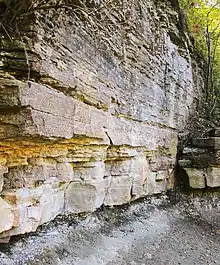Glenwood Shale
The Glenwood Shale is a thin Ordivician shale formation in the sedimentary sequence characteristic of the upper Midwestern United States.
| Glenwood Shale | |
|---|---|
| Stratigraphic range: Ordovician | |
| Type | Formation |
| Underlies | Platteville Formation |
| Overlies | St. Peter Sandstone |
| Location | |
| Country | United States |
| Extent | Minnesota |
| Paleozoic Stratigraphy of the Upper Midwest, USA |
|---|
| Dates approximate |
| Maquoketa Group (446–440 Ma) |
| Galena Group (454–446 Ma) |
|
| Platteville Limestone (455–454 Ma) |
| Glenwood Shale (~455 Ma) |
| St. Peter Sandstone (~459–~455 Ma) |
| Knox supergroup |

The Glenwood shale cropping out in Minneapolis, Minnesota. In this photo, it is the thin, darker layer that lies between the Platteville Limestone (above: the less-eroded, layered unit that constitutes the majority of the photo) and the St. Peter Sandstone (below: a thin, white stripe of in-place rock followed by a slope of eroded St. Peter Sandstone material).
It lies under the Platteville Limestone and above the Saint Peter Sandstone. Together, these three units represent a sequence of sea level rise during Ordovician time. Because it is often very thin (~10 cm or less in the Twin Cities), it is often ignored in the general stratigraphy.
This article is issued from Wikipedia. The text is licensed under Creative Commons - Attribution - Sharealike. Additional terms may apply for the media files.